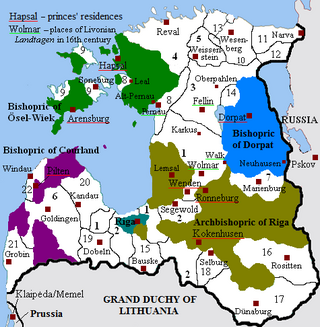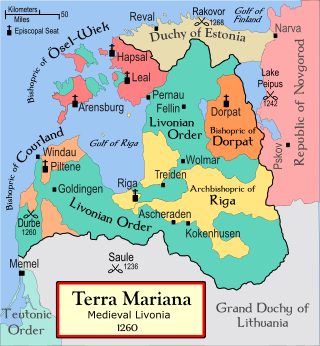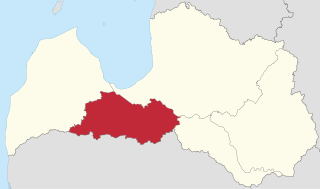Battle
In March 1287, around 1,400 Semigallians attacked the crusader stronghold at Ikšķile and plundered nearby lands. Almost immediately after the attack, the master of the Livonian Order, Willekin von Endorp [ et ], decided to invade Semigallia in revenge. The crusader army consisted of knights of the Order, units of citizens of Riga, and an unknown number of allied Livonians and Latgalians. The crusader army lost its track and wandered for a few days through forests and marshes in Semigallia. Finally, on 26 March, they made camp near the Garoze River [ lv ]. [lower-alpha 1] However, the crusaders were followed by Semigallian scouts, so the location of their camp soon became known to the main Semigallian forces.
The next morning, the Semigallian army attacked the crusaders. At first, the battle went with varying success, but slowly the Semigallians gained the initiative and managed to besiege the crusaders' forces. Many of the knights were killed and many more, including a large number of allies, were taken prisoner. The Rhymed chronicle claims that only a few knights managed get back to Riga. Among the casualties were the master of the Livonian Order, Willekin von Endorp, and the Semigallian commander (sources do not mention his name).

Livonia or in earlier records Livland, is a historical region on the eastern shores of the Baltic Sea. It is named after the Livonians, who lived on the shores of present-day Latvia.
The Northern Crusades or Baltic Crusades were Christian colonization and Christianization campaigns undertaken by Catholic Christian military orders and kingdoms, primarily against the pagan Baltic, Finnic and West Slavic peoples around the southern and eastern shores of the Baltic Sea, and also against Orthodox Christian Slavs.
The Livonian Brothers of the Sword was a Catholic military order established in 1202 during the Livonian Crusade by Albert, the third bishop of Riga. Pope Innocent III sanctioned the establishment in 1204 for the second time. The membership of the crusading order comprised warrior monks, mostly from northern Germany, who fought Baltic and Finnic "pagans" in the area of modern-day Estonia, Latvia and Lithuania. Alternative names of the Order include Christ Knights, Swordbrothers, Sword Brethren, Order of the Brothers of the Sword, and The Militia of Christ of Livonia. The seal reads: +MAGISTRI ETFRM MILICIE CRI (Christi) DE LIVONIA.

The Livonian Order was an autonomous branch of the Teutonic Order, formed in 1237. From 1435 to 1561 it was a member of the Livonian Confederation.

The Battle of Saule was fought on 22 September 1236, between the Livonian Brothers of the Sword and pagan troops of Samogitians and Semigallians. Between 48 and 60 knights were killed, including the Livonian Master, Volkwin. It was the earliest large-scale defeat suffered by the orders in Baltic lands. The Sword-Brothers, the first Catholic military order established in the Baltic lands, was soundly defeated and its remnants accepted incorporation into the Teutonic Order in 1237. The battle inspired rebellions among the Curonians, Semigallians, Selonians, Oeselians, tribes previously conquered by the Sword-Brothers. Some thirty years' worth of conquests on the left bank of Daugava were lost. To commemorate the battle, in 2000 the Lithuanian and Latvian parliaments declared 22 September to be the Baltic Unity Day.

Semigallians were the Baltic tribe that lived in the southcentral part of contemporary Latvia and northern Lithuania. They are noted for their long resistance (1219–1290) against the German crusaders and Teutonic Knights during the Northern Crusades. Semigallians had close linguistic and cultural ties with Samogitians.

The Battle of Aizkraukle or Ascheraden was fought on 5 March 1279 between the Grand Duchy of Lithuania, led by Traidenis, and the Livonian branch of the Teutonic Order near Aizkraukle in present-day Latvia. The order suffered a great defeat: 71 knights, including the grand master, Ernst von Rassburg, and Eilart Hoberg, leader of the knights from Danish Estonia, were killed. It was the second-largest defeat of the order in the 13th century. After the battle Duke Nameisis of the Semigallians recognized Traidenis as his suzerain.

Semigallia, also spelt Semigalia, is one of the Historical Latvian Lands located in the south of the Daugava river and the north of the Saule region of Samogitia. The territory split between Latvia and Lithuania, previously inhabited by the Semigallian Baltic tribe. They are noted for their long resistance (1219–1290) against the German crusaders and Teutonic Knights during the Northern Crusades. Semigallians had close linguistic and cultural ties with Samogitians.
Viestards was one of the greatest Semigallian dukes in the 13th century, referred to as King Vester.
The Battle of Skuodas or Schoden was a medieval battle fought in ca. 1259 near Skuodas in present-day Lithuania during the Lithuanian Crusade. The Samogitian army of 3,000 invaded Courland and on their way back defeated the Livonian Order, killing 33 knights and many more low-rank soldiers. In terms of knights killed, it was the eighth largest defeat of the Livonian Order in the 13th century. This victory led to a Semigallian insurrection against the Livonian crusaders, which lasted from 1259 to 1272.

The Battle of Durbe was a medieval battle fought near Durbe, 23 km (14 mi) east of Liepāja, in present-day Latvia during the Livonian Crusade. On 13 July 1260, the Samogitians soundly defeated the joint forces of the Teutonic Knights from Prussia and Livonian Order from Livonia. Some 150 knights were killed, including Livonian Master Burchard von Hornhausen and Prussian Land Marshal Henrik Botel. It was by far the largest defeat of the knights in the 13th century: in the second-largest, the Battle of Aizkraukle, 71 knights were killed. The battle inspired the Great Prussian Uprising and the rebellions of the Semigallians, the Couronians, and the Oeselians. The battle undid two decades of Livonian conquests and it took some thirty years for the Livonian Order to restore its control.

The Battle of Wesenberg, Rakvere or Rakovor was a battle fought on 18 February 1268 between the combined forces of Danish Duchy of Estonia, Bishopric of Dorpat, Livonian branch of the Teutonic Knights, and local Estonian militia on one side and the forces of Novgorod and Pskov, led by Dmitry of Pereslavl, on the other. Medieval accounts of the battle vary with both sides claiming victory, however the Livonian victory being more plausible as Novgorodian-Pskovian forces retreated out of Danish Estonia, with Livonian Knights launching a retaliatory attack on Izborsk and Pskov soon afterward, in June 1269.

The Livonian crusade consists of the various military Christianisation campaigns in medieval Livonia – modern Latvia and Estonia – during the Papal-sanctioned Northern Crusades in the 12–13th century. The Livonian crusade was conducted mostly by the Holy Roman Empire and the Kingdom of Denmark. It ended with the creation of Terra Mariana and the Danish duchy of Estonia. The lands on the eastern shores of the Baltic Sea were one of the last parts of Europe to be Christianised.

The Battle of Karuse or Battle on the Ice was fought on 16 February 1270 between the Grand Duchy of Lithuania and the Livonian Order on the frozen Baltic Sea between the island of Muhu and the mainland. The Lithuanians achieved a decisive victory. The battle, named after the village of Karuse, was the fifth-largest defeat of the Livonian or Teutonic Orders in the 13th century. Almost all that is known about the battle comes from the Livonian Rhymed Chronicle, which devoted 192 lines to the battle.
Otto von Lutterberg was the Landmeister of the Livonian Order of the Teutonic Knights from 1267 to 1270.

Dobele Castle is a castle in the town of Dobele in the historical region of Zemgale, Latvia. The Livonian order built the castle on the west bank of the Berze river in 1335, on the site of an old hillfort.

The Curonians or Kurs were a Baltic tribe living on the shores of the Baltic Sea in what are now the western parts of Latvia and Lithuania from the 5th to the 16th centuries, when they merged with other Baltic tribes. They gave their name to the region of Courland (Kurzeme), and they spoke the Curonian language. Curonian lands were conquered by the Livonian Order in 1266 and they eventually merged with other Baltic tribes contributing to the ethnogenesis of Lithuanians and Latvians.

Terra Mariana was the official name for Medieval Livonia or Old Livonia. It was formed in the aftermath of the Livonian Crusade, and its territories were composed of present-day Estonia and Latvia. It was established on 2 February 1207, as a principality of the Holy Roman Empire, but lost this status in 1215 when Pope Innocent III proclaimed it as directly subject to the Holy See.
Nameisis or Namejs was a Semigallian duke in the second half of the 13th century. He ruled in the western part of Semigallia, with his capital at Tērvete. In 1279–81, he led a Semigallian uprising against the Livonian Order, a crusading military order. Very little is known about his life. He is mentioned only in the Livonian Rhymed Chronicle and in some documents from the 14th century. For this reason he is sometimes referred as semi legendary ruler in Latvian historiography.

The Livonian campaign against Rus' was a military campaign that lasted from 1240 to 1242, and was carried out by the Teutonic Knights of the Livonian Order with the aim to conquer the lands of Pskov and Novgorod and convert them to Catholicism.










